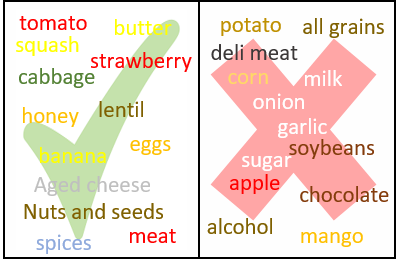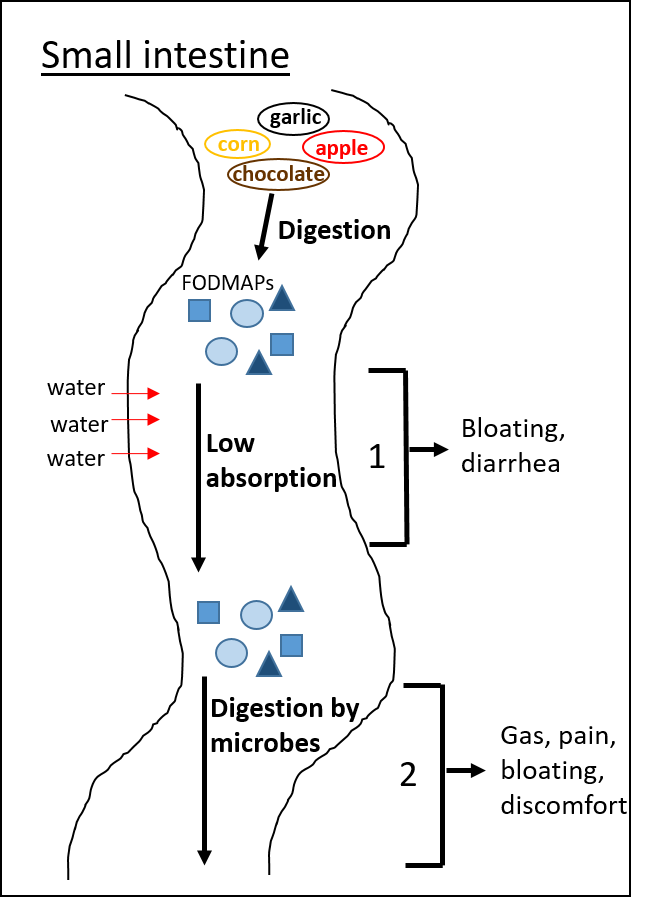
No bread. No sugar. No rice, potatoes, corn, soy, milk, onions, garlic, chocolate, processed meats, or alcohol. Is this a starvation diet or a method of torture? Actually, this is a diet with a 70–86% success rate in relieving the symptoms of a disorder that is notoriously difficult to treat. This diet is called the “low-FODMAP” diet, which is short for “restriction of Fermentable Oligosaccharide, Disaccharide, Monosaccharide, and Polyols in the diet”. Thank goodness for the FODMAP acronym to prevent that mouthful of words!
The low-FODMAP diet treats a disorder called Irritable Bowel Syndrome (IBS), which is characterized by stomach pain, bloating, diarrhea or constipation, and general gastrointestinal discomfort. According to Dr. Miranda van Tilburg, an associate professor in medicine from UNC-Chapel Hill who studies IBS, people with IBS often have a very low quality of life. “Those with IBS frequently miss days of work and school, and anxiety and depression are very common as people worry about future symptoms and how those symptoms will impact their life,” she says.
IBS is a common disorder with a global prevalence of 10-20%. It is clinically diagnosed based on certain symptoms. Unfortunately, the exact cause of IBS is unknown, but it is thought to be triggered by multiple issues including changes in gut motility, increased sensitivity of intestinal nerves, bacterial growth in the small intestine, intestinal inflammation, and psychological factors. Although medicines exist to treat IBS, they do not always provide adequate relief and often cause unwanted side effects. Instead, a combination of diet, exercise, and even hypnotherapy often provide more relief with fewer side effects.
A large component of treatment for IBS is diet management. Tilburg points out a few well-known triggers of IBS symptoms, including spicy and fatty foods, along with incompletely absorbed carbohydrates. The low-FODMAP diet specifically addresses the latter dietary component.
What are FODMAPs, and how can a diet low in FODMAPs treat IBS symptoms? FODMAPs are carbohydrates, such as lactose, fructose, and sugar alcohols, that are difficult to absorb in the small intestine. When the FODMAPs are not absorbed, they produce intestinal water and gas. For various reasons, those with IBS often have more difficulty when consuming FODMAPs than other people.

The mechanism behind FODMAP-induced discomfort is twofold. First, when FODMAPs are not fully absorbed, they remain in the small intestine and attract water, which enters the small intestine in a process called osmosis. This leads to bloating as well as increased water delivery to the large intestine, which can cause diarrhea. Second, incompletely absorbed FODMAPs can be fermented by intestinal microbiota, leading to gas, which causes pain, bloating, and general discomfort.
Consequently, for some people with IBS, a diet low in these offending carbohydrates can be beneficial. In fact, six randomized controlled trials have shown benefits for IBS patients who consume a low-FODMAP diet. However, this diet is very restrictive concerning which foods can be eaten, so people can have trouble adhering to the diet if they are not properly supported by clinical guidance.
One question that many people ask is: how can someone follow a diet that cuts out virtually all of the delicious foods that are normally eaten? Although this diet is restrictive, it offers a good chance at relief for people who have usually lived with pain for years. And this diet is not meant to be followed forever. Tilburg explains that “every person’s case of IBS is unique, and every person will have different foods to which they are sensitive.” So after following the low-FODMAP diet for 2-6 weeks to reduce the food-induced symptoms, the excluded foods are slowly added back, and the patient is monitored by a dietician for adverse symptoms. If a certain food increases symptoms, then it is removed from the diet and other foods are tried instead.
Although it may seem impossible to go without your favorite chocolate cake or garlic bread, people with IBS often welcome the chance to reduce their symptoms, even if it requires a sacrifice of ice cream and deli sandwiches.
Peer edited by Alexandria Mullins.
Follow us on social media and never miss an article:
Can you tell me about rice ?? I’ve read different things some say yes some say no? I seem to be ok with white rice but I’m worndering if I should cut it out
Thanks for the info
Michelle
Michelle, usually I have seen that ALL grains, including rice and potatoes, are eliminated during the low-FODMAP diet. I personally followed the low-FODMAP diet for a while, and I found that some of my symptoms went away when I eliminated rice. Again, this is meant to be a short-term diet, so rice is not eliminated forever!
I see that potatoes are eliminated but what about sweet potatoes?
Most FODMAP diets allow sweet potatoes in small quantities (i.e. no more than 1 serving or 1/2 cup per day). However, this can also be left up to personal preference, where if sweet potatoes do not seem to bother you, then you can have more, while if they cause issues, then they should be minimized.